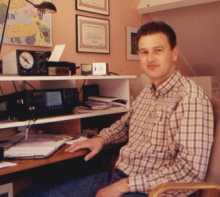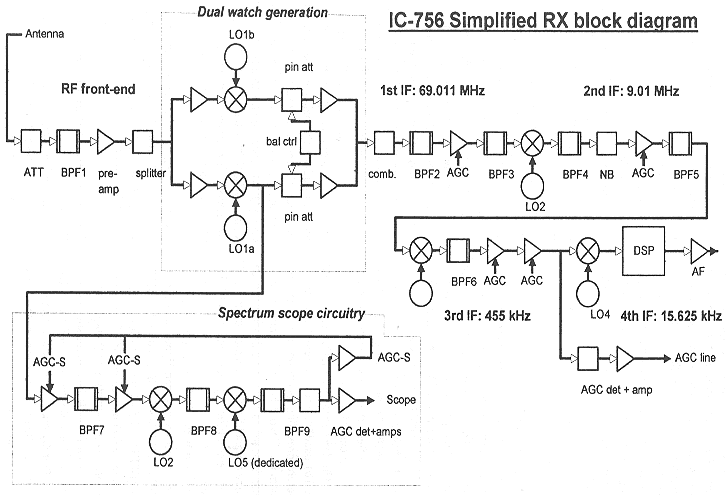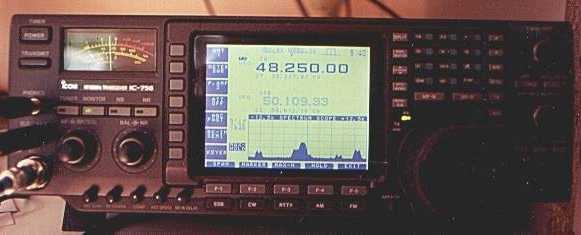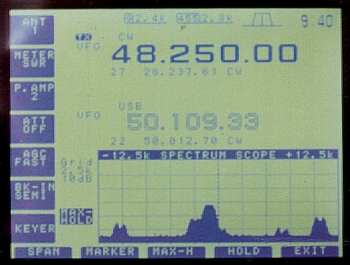| The
IC-756, a Step Forward for HF and Six Metre DX |
 |
|
| Frank with his new toy! | by Frank van Dijk, PA3BFM, Six News August 1997 |
| The
IC-756, a Step Forward for HF and Six Metre DX |
 |
|
| Frank with his new toy! | by Frank van Dijk, PA3BFM, Six News August 1997 |
When I first heard about the IC-756 I was immediately attracted to it, as it promised to be the first HF plus six metre transceiver that included some of the more advanced features that used to belong to the up-market models. I’m quite happy to review this transceiver here for you. In many areas a transceiver manufacturer nowadays has the choice between conventional circuitry and digital circuitry. The latter is not always superior over conventional electronics. In this article I hope to show you how successful Icom has been with its newest product. We will take a look at some of the novel features present on the IC-756: ‘Dual watch’, a large LCD screen and a spectrum scope.
As the IC-756 is being advertised as a ‘DSP-receiver’, we will also see how the DSP is configured in the IC-756. This article will concentrate on the receive branch of this transceiver. Enno Korma, PA0ERA has prepared a special simplified block diagram of the IC-756 receiver. I will refer to this block diagram throughout this article.

This is an un-biased review as I have no direct or indirect commercial interests in the manufacturing or marketing of amateur radio equipment.
 General
General
The IC-756 receiver has four IFs: 69.011 MHz, 9.01 MHz, 455 kHz and a ‘semi’ IF at 15.625 kHz at which the DSP operates. One additional IF filter can be installed in the 9.01 MHz (BPF5) and 455 kHz IF (BPF6). The full range of ICOM IF filters is at your disposal for this purpose. I have optimised my IC-756 for CW, so I have installed a 500 Hz CW filter at 9.01 MHz, and for digging the weak ones out of the noise a 250 Hz CW filter at 455 kHz. Twin passband tuning (two IF shifts) is available to narrow the IF passband at 9.01 MHz and 455 kHz. This eliminates to a large extent the need for narrow SSB filters.
Two receive pre-amplifiers are available: one for the HF bands below 21 MHz and one for the bands above 21 MHz. The second pre-amp seems to be optimised for 50 MHz and increases the sensitivity to a state-of-the-art 0.13uV. Two antenna ports are provided and a separate connector for a receive antenna as well; there is no transverter port. The automatic antenna tuner works flawlessly, although you lose one dB or so due to unavoidable insertion loss on 50MHz.
The transmitter power amplifier works from 160 metres straight through to six metres and employs a pair of 2SC2694 bipolar transistors. A dedicated jack is provided to T/R switch an external linear amplifier. It is rated at 16 VDC/2A. I have used the IC-756 in a contest (on 14 MHz) for five hours non-stop and it didn’t get hot at all.
The IC-756 needs an external 13.8V DC power source.
‘Dual Watch’
Recently the major Japanese manufacturers of ham radio equipment have incorporated a feature called ‘Dual Watch’ in some of their products. There is a big difference between ‘Dual Watch’ and main/sub receiver capability that is known in high-end transceivers such as the Yaesu FT1000MP. In order to get the ‘Dual Watch’ effect, the received signal is split at the front end RF level.
The first local oscillators (LO1a and LO1b) oscillate on different frequencies, thereby providing reception on separate frequencies. Two PIN diode attenuators provide a means to vary the balance between the two branches. Subsequently the two signals are combined again to one, first IF signal.
‘Dual Watch’ is a clever system to generate a second received signal on a different frequency within the front-end band filter (BPF1), without the need for a second IF-stage, a second receiver AGC circuit (automatic gain control) or AF stage. Compared to a fully-fledged main/sub receiver system, ‘Dual Watch’ is more cost effective, thereby enabling the manufacturer to add yet another attractive feature to a transceiver without over-pricing it.
Obviously, ‘Dual Watch’ is a bit simplistic compared to a main/sub receive system. The latter has separate IF-stages and AGC-circuit, making the two receivers work more or less independently of each other. With ‘Dual Watch’ things are different, e.g. it is not possible to listen to a 50095 QSO in CW mode using a narrow IF filter and at the same time listen to a QSO in USB on 50145 using a wide IF filter. There’s just one receiver! When ‘Dual Watch’ is switched on the noise increases by about 3 dB. So when you’re expecting marginal signals, it is advisable not to use it.
Another limitation is caused by the AGC circuit. The AGC voltage is a function of the sum of the two received signals, irrespective of how weak or strong each individual signal is. What happens? When the two signals are of about equal strength, they both produce enough audio to be copied successfully. When one signal is much stronger than the other, there still is no problem because Icom has provided a manual control to adjust the balance (‘bal ctrl’ in the block diagram). The real trouble starts when the signals vary in strength, or when strong QRM appears on the frequency. The weaker signal will be wiped out by the AGC. OK, restore the balance and there it is again. When the QRM is gone, restore the balance once more. To cut a long story short, due to this effect, ‘Dual Watch’ is unsuitable for a dynamic environment, such as a densely populated HF band, or a huge pile up for a weak DX station.
The main advantage of ‘Dual Watch’
What do I use ‘dual watch’ for? I use it for what it has been designed to do and that is to watch or to monitor things. It is an ideal tool to improve your hunting activities. In an opening I constantly tune up and down the band and check all QSOs for new squares. ‘Dual Watch’ enables me to stop and listen to a QSO and move on up the band at the same time. Or it helps to monitor the activity on 50.110 (the place where it all happens) and make QSOs on another frequency. ‘Dual Watch’ is helpful as long as you use it for its intended purpose. Don’t expect to work cross band with it or work the pile ups in full stereo.
In any case, I believe more development is necessary here. An improvement in the balance control, by some kind of automatic or dynamic system, should be achievable. This will certainly increase the over-all flexibility of the ‘Dual Watch’ system.
 The
LCD display
The
LCD display
It’s new, it’s blue and there’s no denying: it’s beautiful! The LCD screen is 11cm wide and 8cm high. That’s large! The screen is the prime interface between the user and the 756 electronics. Because of the size of the screen, the information can be presented to the operator in a clear and luxurious fashion. For instance, when you switch to memory mode, the screen shows a scrollable list of the memory contents, including a 10 character programmable text field for each memory channel. I use these text fields to list the name and the grid locator of the beacon in that particular channel. Now I never forget what the beacon was on 50023.5 MHz: SR5SIX, LX0SIX, 9H1SIX or was it OH1SIX?
The display and the plain language sub-menus clearly tell you what you are doing or changing. This in fact partly replaces a user manual and is a big improvement over the complicated and un-intuitive power-up menus that are available on other rigs. The following anecdote shows how easy it is to operate an IC-756. When I got my IC-756 for the first day, after just having it unpacked, I noticed that VK0IR was on 30 metres. This was the first day of their activity and I had never worked Heard Island on any band. I was able to work the station within 10 minutes without ever looking in the manual! That is barefoot, on a sloping dipole poised at 21m.
The Spectrum Scope
The lower half of the LCD screen is used for the spectrum scope. Take a look at the block diagram and recognise that the panorama on the scope is created by a dedicated receiver. LO5 is a sweeping or scanning oscillator that sweeps a user definable band segment around the 756’s main receive frequency. This sweeping is performed at quite high speed so that a CW station transmitting at 20 wpm nicely appears as a perfect half sine wave. The quality of SSB signals, in many cases the lack thereof, is also clearly visualised. The following spans are available: plus or minus 12.5kHz, 25kHz, 50kHz and 100kHz. Evidently, at the wider spans some detail has to be sacrificed.
Forget the gimmick on the 706! The spectrum scope on the 756 really works! After an initial learning period, I have come to appreciate it more and more. Why? The scope enables me to look around my working frequency and it reveals any other action going on, e.g. stations that I may otherwise overlook. In a standard inter-European opening nowadays a full 100kHz is being used (wow!) and the spectrum scope increases my monitoring ability. Imagine: at the push of a button I get a view of the entire 49.750 MHz video cluster!
The scope is slightly under-sensitive on 50MHz. It will not show signals that are near the noise level, a signal has to be S3 to be visible at all. On the other hand, on the lower HF bands (14 MHz and down) its sensitivity seems to be OK but the scope shows so many signals that it’s no longer of any practical use, unless you just want to get an idea of the general band population. On 50 MHz I use the scope all the time and even feel disoriented when not using it. Combined with ‘dual watch’, almost nothing escapes my attention! I don’t ever want to have a rig without these features!
An appropriate modification would be to increase the scope’s sensitivity above 21 MHz and reduce it a little below 21 MHz.
Digital Signal Processing
I am highly critical about the use of DSP in amateur receivers. Especially for reception of signals that are very close to the noise level, I believe DSP technology in amateur equipment is not yet capable to outperform IF filtering and the good old human ear. So why use it? I have owned several DSPs, including the most expensive, but after some time I have said goodbye to all of them! Only on aurora have I found a notable and reproducible improvement, when DSP was used in noise reduction mode.
The DSP in the 756 didn’t make me change my mind, but in comparison to the other DSPs that have lived in my shack it performs excellently!
As you can see in the block diagram, the DSP is placed after the 455 kHz IF and AGC detector/amplifier. I think the point in filtering is that you want to filter the desired signal out before it reaches the AGC detector, not after. When you filter after the AGC detector, undesired and strong signals will still influence weak signals. An alternative for this is found in the Kenwood TS-870, where the DSP unit also controls the entire AGC performance. In the IC-756 however, the DSP apparently has a more auxiliary function. For good filtering, you must rely upon traditional IF filters: crystal filters in the 9.01 MHz IF (BPF 5) and the 455 kHz IF (BPF 6).
What DSP functions are available on the IC-756?
New transceivers are hitting the market that have no 455 kHz IF and don’t even provide a full range of filters for a higher IF, depending largely on DSP filtering. I would love to try one of those and if Chris allows it, I’ll share my experience with you in a future ‘Six News’.
Strong signal handling capability
The two major parameters to quantify a receiver’s behaviour under the reception of strong signals are IMD dynamic range and 3rd order intercept point. In the context of this review it would take too long to elaborate on this subject. Anyway, when I requested my local ICOM affiliate for information about the IC-756’s strong signal handling abilities, I was provided with the following undocumented specifications: 105dB for the IMD dynamic range and +21dBm for 3rd order intercept point. Recent measurements in the ARRL Laboratory (see: Further Reading) more or less confirm these figures so that the IC-756 sees itself placed in the upper middle class of ‘Receiver Society’.
On 30 metres HF (10.100 MHz) during sunset hours, very weak 3rd order products can be detected, using the sloping dipole mentioned earlier. These products (carriers every 5kHz) are caused by the ‘forest’ of ultra strong AM broadcast stations in the 31 metre broadcast band, just 100kHz below the 30 metre amateur band. With the insertion of 6dB of Front End attenuation, these products vanished. Apart from the products detected in this extreme situation, no other unwanted or non-existing signals can be heard on the IC-756. Moreover, generally speaking 50MHz is a less harsh RF environment than HF. I have no knowledge of any practical tests to give you an estimate of a receiver’s dynamic range.
Conclusion
The IC-756 is a high quality contemporary transceiver. It doesn’t represent the avant garde in transceiver design. Digital technology is being used in a sensible and conservative way, for the purpose of creating added value for the user and not to satisfy the marketing department or to cut production costs. Many thanks to Enno Korma, PAØERA for preparing the block diagram and for his useful comments and additions.
Further reading:
This review concentrates on some of the technological aspects of the IC-756 receiver. If you desire more general information, I recommend the following articles:
*1 Some frequency bands are not
guaranteed
*2 Depending on version
*1Less than VSWR 3:1; *2Less than VSWR 2.5:1
![]() To return to the archive page click here
To return to the archive page click here